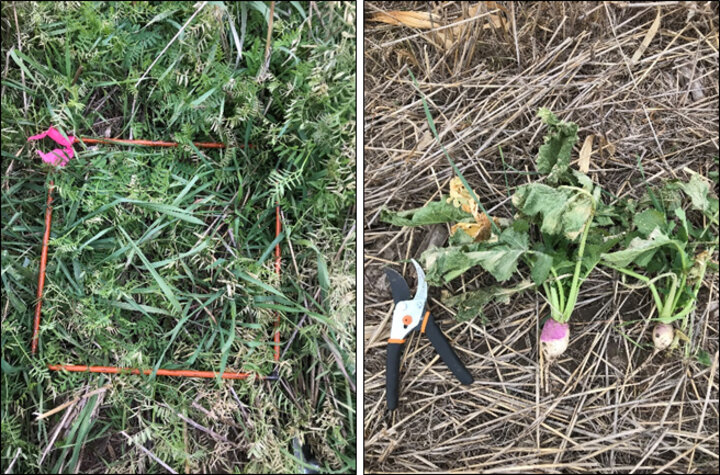Cover crops are becoming popular across Nebraska and much of the Corn Belt. Producers in western Nebraska are interested in knowing whether and/or how cover crops could be incorporated into their cropping systems. Cover crops have the potential to reduce soil erosion and compaction, increase water holding capacity and soil organic matter, and suppress weeds. One of the major concerns regarding the inclusion of cover crops in the wheat-corn-fallow rotation is the amount of water used by these “non-cash” species and potential yield reduction of the subsequent crop.
Cover Crop Planting and Termination Time

Treatment and Study Design
- Three cover crop planting times
- Four cover crop termination times
- Corn planted mid- to late-May
- Sites: Grant and North Platte
- The study was replicated twice (two locations, two years totaling four site-years)
In the wheat-corn-fallow rotation, cover crops can be planted right after winter wheat harvest in July. Winter-sensitive species will grow during the fall and winter-kill after the first frost. Winter-hardy species resume growth in the spring and need to be terminated either chemically (herbicide) or mechanically (incorporated into the soil).
- Three cover crop planting times: three, six and nine weeks after winter-wheat harvest.
- Four cover crop termination times: no cover crop; terminated during winter (winter-kill); terminated with herbicide two weeks prior to corn planting; and terminated with herbicide at corn planting.
- Cover crop winter-sensitive species mix: black oats, spring barley, spring lentil, and daikon radish; seeding rate of 63 lbs/ac.
- Cover crop winter-hardy species mix: winter barley, winter triticale, hairy vetch, and daikon radish; seeding rate of 57 lbs/ac.
- Soil water content was monitored biweekly during the early corn growing season using the TDR sensor.
Results
Early cover crop planting resulted in higher cover crop biomass during the fall. There is more flexibility in cover crop planting time after wheat harvest to produce biomass in the spring.
Delayed cover crop termination resulted in corn grain yield reduction. The winter-hardy late planting and early termination treatment combination had the least impact on corn yield.
Cover Crop Species Selection

Different cover crop species may have specific effects on cropping systems of western Nebraska. Brassicas may reduce soil compaction and increase nutrient cycling; legumes can fix nitrogen to the soil, and grasses have the greatest potential for biomass production, giving an opportunity for grazing and helping suppress weeds.
Treatment and Study Design
- Eight CC species
- Cover crop species drilled right after winter-wheat harvest
- Corn planted mid to late-May
- Sites: Grant and North Platte
- Study was replicated twice
- Cover crop species treatments and rates: no cover crop, spring triticale (60 lbs/ac), cereal rye (60 lbs/ac), spring oat (60 lbs/ac), purple top turnip (20 lbs/ac), kale Siberian (20 lbs/ac), balansa clover (20 lbs/ac) and hairy vetch (40 lbs/ac).
- Spring triticale, spring oat, purple top turnip, and kale Siberian died in the winter. Cereal rye, hairy vetch and balansa clover were terminated with herbicide in the spring.
- Soil water content was monitored during early corn growing season bi-weekly using the TDR sensor.
- Weed counts and biomass were collected at corn V6 growth stage.
Results
Brassicas and spring oat produced the highest biomass in the fall. Cereal rye reached the highest biomass accumulation during the spring.
In general, cover crops reduced weed population. Cereal rye had the biggest impact on weed suppression. Overall, cover crop species reduced corn grain yield. In wet years, there was less of an impact of cover crop species in corn grain yields.
Take-home Lessons
In semi-arid rainfed areas, the timing of cover crop termination is key to avoiding excessive cover crop growth, water use, and nitrogen immobilization, and consequently, reduce corn grain yield. Brassicas and oats have the greatest potential for biomass accumulation during the fall. Cereal rye has the greatest potential for biomass accumulation during the spring, but it also has the highest detrimental effects on corn yield. Moreover, wheat farmers are concerned about the weediness potential of cereal rye; thus, an alternative cool-season grass species such as triticale may be a better option. Also, some cover crops can host wheat diseases — an important consideration when selecting cover crop species.

